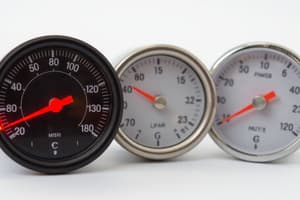Podcast
Questions and Answers
Describe the relationship between temperature and kinetic energy.
Describe the relationship between temperature and kinetic energy.
The higher the temperature, the more kinetic energy there is.
Describe the way in which thermometers measure temperature.
Describe the way in which thermometers measure temperature.
A thermometer measures temperature through a glass tube sealed with alcohol that expands or contracts as the temperature rises or falls.
How can you explain thermal expansion in terms of kinetic energy?
How can you explain thermal expansion in terms of kinetic energy?
Heat causes the molecules to move faster, which means that the volume of a solid or a liquid increases.
If a mercury thermometer shows that the air temperature is 22 °C (72 °F), do particles in the air have more average kinetic energy than particles in the mercury? Explain.
If a mercury thermometer shows that the air temperature is 22 °C (72 °F), do particles in the air have more average kinetic energy than particles in the mercury? Explain.
If a puddle of water is frozen, do particles in the ice have kinetic energy? Explain.
If a puddle of water is frozen, do particles in the ice have kinetic energy? Explain.
Why might a sidewalk be built with periodic breaks in it?
Why might a sidewalk be built with periodic breaks in it?
Flashcards are hidden until you start studying
Study Notes
Temperature and Kinetic Energy
- Higher temperatures correlate with increased kinetic energy in particles.
Thermometers
- Thermometers utilize a glass tube sealed with alcohol.
- Alcohol expands in the bulb as temperature rises, moving into a calibrated capillary tube.
- The expansion rate is marked on a glass scale, allowing for accurate temperature readings.
Thermal Expansion and Kinetic Energy
- Heat increases molecular motion, converting heat energy to kinetic energy.
- Resulting increased motion leads to changes in volume for solids and liquids.
Kinetic Energy in Thermometers
- Particles in the air at 22 C (72 F) and in mercury exhibit the same average kinetic energy.
Kinetic Energy in Ice
- Particles in ice have minimal kinetic energy as their movement is restricted at cold temperatures.
Sidewalk Design
- Sidewalks incorporate breaks to accommodate thermal expansion and contraction.
- This design prevents stress-related cracks due to changes in temperature.
Studying That Suits You
Use AI to generate personalized quizzes and flashcards to suit your learning preferences.




